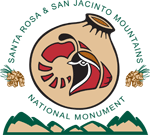Santa Rosa & San Jacinto Mountains National Monument
Getting Oriented :
You may have heard about this new national monument and still be a bit vague on where it is exactly. So here's how you find it:
If you're driving into Palm Springs from Los Angeles, the Santa Rosa and San Jacinto Mountains National Monument begins where Highway 111 breaks away from Interstate 10. If you follow 111 through the Palm Springs Valley and look to your right, you're roughly following the base of the monument all the way to the northern reaches of the Salton Sea.
The southern edge of the monument abuts the Anza Borrego Desert State Park near Travertine Rock. Up in the mountains, the western boundary is just beyond the ridgeline.
Once you've found the boundaries, you'll want to get oriented to landmarks. The first object that's likely to arrest your attention is 10,834-foot Mount San Jacinto. Whether adorned with snow or the red beacon of the Palm Springs Aerial Tramway Station, the mountain is an imposing centerpiece to the national monument.
J. Smeaton Chase prized his view of the mountain's face from his camp in Chino Canyon, noting that the peak rears up from the surrounding desert: "Explicit, bald, almost artificial."
Explicit, indeed. The northeastern face of San Jacinto is one of the steepest escarpments in the United States.
The rapid rise influences nearly everything about the monument, from weather to animal and plant diversity to Indian patterns of habitation. The abrupt rise also makes the mountain appear shockingly close to the valley floor. From your hotel room or patio, you can almost reach out and pet San Jack's flank.
It's this extreme vertical relief that allows for immediate and unparalleled access from desert resort to wilderness. "There's a dramatic interface here between solitude and city," says Buford Crites. "You only need to take a couple of twists and turns up a canyon or a ridgeline and the urban world of Southern California is gone."
"I can get from town onto a trail in five minutes," adds Jeff Morgan, vice chair of conservation for the Sierra Club's Tahquitz Group. "It takes me usually less than 10 minutes from my house to get to the tram and less than 20 minutes to get off the tram. I know the schedules, so I park my car and off we go."
Looking south of the white granite spurs of San Jacinto, you'll see a broad divide where Palm Canyon - one of the Indian Canyons - cleaves the Santa Rosa and San Jacinto ranges. The gap is often filled with curls of cloud pushing in from the wetter western side of the mountains.
South of the Indian Canyons, the mountains seem to wrap around to your left. These are the little-known Santa Rosas. Only a few field biologists and manic hikers can claim true intimacy with these mountains.
It takes awhile to appreciate the beauty of this boulder range, but lest you think the Santa Rosas are drab, wait until sunrise or sunset when layer upon layer of ridges and ranges are revealed. It's like you've donned 3D glasses. Changing light on these mountains makes for nonstop "topographical surprise," says Chase.
You'll easily spot the prominent 8,716-foot peak of Toro and nearby Santa Rosa mountains, but don't assume the sentinels you see are all there is.
People can live in Palm Springs Valley for years and believe there are only three or four peaks in the local mountains and only one monster: San Jacinto. Surprise. There are at least four additional peaks topping 10,000 feet in the San Jacintos. The Santa Rosas, too, are well-stocked with peaks worth exploring.
Morgan should know. "I've been on every peak on the ridge dozens of times," he says. "Folly Peak, Jean Peak, Marion Mountain, Tahquitz and Red Tahquitz peaks, Apache and Spitler peaks, Eisenhower Mountain, Rabbit Peak . . ."
While Morgan takes to the ridgelines in summer, he heads for the cool canyons in winter. This truly is a monument of charismatic canyons, each with its own character. From north to south, there's Snow Creek Canyon (best mountain view in Southern California), Tachevah with its massive wedge of blue-gray granite, and Chino Canyon, former home of Cahuilla Indian shaman Pedro Chino.
And Tahquitz. This is the legendary home of a malevolent spirit who makes rude noises and launches occasional guerrilla attacks on hikers. While camping in this canyon, Chase was awakened one night by old Tahquitz rumbling in his ear.
Then there are the Indian Canyons. If San Jacinto is the lofty figurehead of the monument, the Indian Canyons are its warmer heart. For travelers, the canyons' creeks, pools and shady groves of Washingtonia filifera palms provide a welcome antidote to sun, wind, and cholla punctures.
Chase once fell into a state of near-intoxication watching "moon arrows" flashing from polished palm fronds in a palm oasis. The Indian Canyons, he said, "never fail to draw a tribute of surprised approval from even the callous globe-trotter."
The lesser-known canyons of the Santa Rosas include Toro, Martinez and Deep Canyon, home of the Philip L. Boyd Deep Canyon Desert Research Center, part of the University of California Natural Reserve System. While you can't visit Deep Canyon (it's maintained in a pristine state to aid biological research), you can glimpse its tantalizing depths from the Cahuilla Tewanet Overlook on Highway 74.

